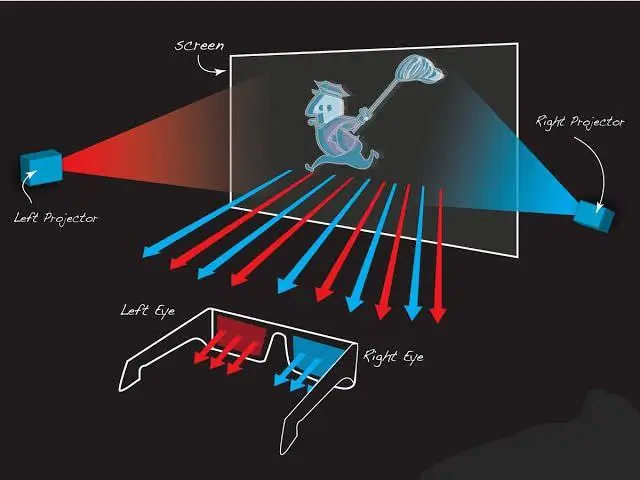How do the 3D Movies work?
If you look at an object near you and close your left and right eyes in turn, you’ll see that each has a slightly different view of the world. Your left eye sees a bit more of the left side of the object, and your right eye sees a bit more of its right side. Your brain fuses the two images together allowing you to see in three dimensions. This is known as stereoscopic vision.
To create a similar effect, 3D films are captured using two lenses placed side by side, just like your eyes (or by producing computer generated images to replicate the same effect).
In old fashioned 3D films, footage for the left eye would be filmed using a red lens filter, producing a red image, and footage for the right eye would be shot using a blue filter, resulting in a blue image. Two projectors then superimposed the images on the cinema screen.
3D glasses with blue and red filters ensured viewers’ left and right eyes saw the correct image: the red filter would only let red light through to your left eye, and the blue filter would only let blue light through to your right eye. Your brain would then combine these two slightly different images to create the illusion of 3D. Unfortunately, this meant that old fashioned 3D films couldn’t make full use of colour.
To get around this problem, modern 3D films use polarised light instead of red and blue light.
What is polarised light?
A polarised light wave vibrates on only one plane. The light produced by the sun is unpolarised, meaning it is made up of light waves vibrating on many different planes. It can however be transformed into polarised light using a polarising filter.
A polarising filter has tiny parallel lines etched into it, a bit like the slats on a set of venetian blinds. This means it will only let light vibrating on a particular plane through.
As with old fashioned 3D, the film is recorded using two camera lenses sat side by side. But in the cinema, the two reels of film are projected through different polarised filters. So images destined for viewers’ left eyes are polarised on a horizontal plane, whereas images destined for their right eyes are polarised on a vertical plane.
3D glasses use the same polarising filters to separate out the two images again, giving each eye sees a slightly different perspective and fooling the brain.
3डी फिल्में कैसे काम करती हैं?
यदि आप अपने पास की किसी वस्तु को देखते हैं और बारी-बारी से अपनी बाएँ और दाएँ आँखें बंद करते हैं, तो आप देखेंगे कि प्रत्येक का दुनिया के बारे में थोड़ा अलग दृष्टिकोण है। आपकी बाईं आंख वस्तु के बाईं ओर को थोड़ा अधिक देखती है, और आपकी दाहिनी आंख उसके दाईं ओर को थोड़ा अधिक देखती है। आपका मस्तिष्क दो छवियों को एक साथ जोड़ता है जिससे आप तीन आयामों में देख सकते हैं। इसे त्रिविम दृष्टि के रूप में जाना जाता है।
समान प्रभाव पैदा करने के लिए, आपकी आंखों की तरह, अगल-बगल रखे गए दो लेंसों का उपयोग करके (या उसी प्रभाव को दोहराने के लिए कंप्यूटर से उत्पन्न छवियां बनाकर) 3डी फिल्में कैप्चर की जाती हैं।
पुराने जमाने की 3डी फिल्मों में, बाईं आंख के फुटेज को लाल लेंस फिल्टर का उपयोग करके फिल्माया जाता था, जिससे एक लाल छवि बनती थी, और दाईं आंख के फुटेज को नीले फिल्टर का उपयोग करके शूट किया जाता था, जिसके परिणामस्वरूप एक नीली छवि बनती थी। फिर दो प्रोजेक्टरों ने छवियों को सिनेमा स्क्रीन पर सुपरइम्पोज़ किया।
नीले और लाल फिल्टर वाले 3डी चश्मे ने यह सुनिश्चित किया कि दर्शकों की बायीं और दायीं आंखें सही छवि देखें: लाल फिल्टर केवल लाल रोशनी को आपकी बायीं आंख में जाने देगा, और नीला फिल्टर केवल नीली रोशनी को आपकी दाहिनी आंख में जाने देगा। फिर आपका मस्तिष्क 3डी का भ्रम पैदा करने के लिए इन दो थोड़ी भिन्न छवियों को संयोजित करेगा। दुर्भाग्य से, इसका मतलब यह हुआ कि पुराने ज़माने की 3डी फ़िल्में रंग का पूरा उपयोग नहीं कर सकीं।
इस समस्या से निजात पाने के लिए आधुनिक 3डी फिल्में लाल और नीली रोशनी के बजाय ध्रुवीकृत प्रकाश का उपयोग करती हैं।
ध्रुवीकृत प्रकाश क्या है?
एक ध्रुवीकृत प्रकाश तरंग केवल एक तल पर कंपन करती है। सूर्य द्वारा उत्पन्न प्रकाश अध्रुवीकृत होता है, अर्थात यह कई अलग-अलग तलों पर कंपन करने वाली प्रकाश तरंगों से बना होता है। हालाँकि इसे ध्रुवीकरण फिल्टर का उपयोग करके ध्रुवीकृत प्रकाश में बदला जा सकता है।
एक ध्रुवीकरण फ़िल्टर में छोटी-छोटी समानांतर रेखाएँ खुदी हुई होती हैं, जो कुछ-कुछ वेनिस के पर्दों के सेट पर लगी स्लैट्स की तरह होती हैं। इसका मतलब यह है कि यह केवल एक विशेष तल पर कंपन करने वाले प्रकाश को ही गुजरने देगा।
पुराने ज़माने के 3डी की तरह, फिल्म को अगल-बगल बैठे दो कैमरा लेंसों का उपयोग करके रिकॉर्ड किया जाता है। लेकिन सिनेमा में, फिल्म की दो रीलों को अलग-अलग ध्रुवीकृत फिल्टर के माध्यम से पेश किया जाता है। इसलिए दर्शकों की बाईं आंखों के लिए बनाई गई छवियां क्षैतिज तल पर ध्रुवीकृत होती हैं, जबकि उनकी दाहिनी आंखों के लिए बनाई गई छवियां ऊर्ध्वाधर विमान पर ध्रुवीकृत होती हैं।
3डी चश्मा दो छवियों को फिर से अलग करने के लिए समान ध्रुवीकरण फिल्टर का उपयोग करते हैं, जिससे प्रत्येक आंख को थोड़ा अलग परिप्रेक्ष्य मिलता है और मस्तिष्क को बेवकूफ बनाया जाता है।




